To many birders, chattering and chirping in the morning is one of the best sounds in the world. It is exciting, peaceful, and a delight for the ears.
But it can be difficult to know which birds you hear in the morning. That’s why we’re taking a look at some of the birds you’re most likely to hear at sunrise, to help you identify who’s singing your favorite tune. This list will include birds from all over North America and beyond. So, pay attention to which on the list live in your geographic area before trying to identify them.
Key Takeaways
- Early morning bird songs come from species like the American Robin, American Yellow Warbler, Baltimore Oriole, Gartered Trogon, Tufted Titmouse, and Red-Winged Blackbird. Each bird has distinctive calls and reasons for their dawn choruses.
- Birds sing for several reasons, including attracting mates, defending territory, and warning others of predators’ presence.
- Taking advantage of tools like the Cornell Lab of Ornithology’s Merlin app is an easy way to identify the birds you hear each morning.
North American Birds That Sing and Call in the Morning
If you live in the same North American region as any of these six birds, you’ll probably hear them in the morning — especially the males!
American Robin
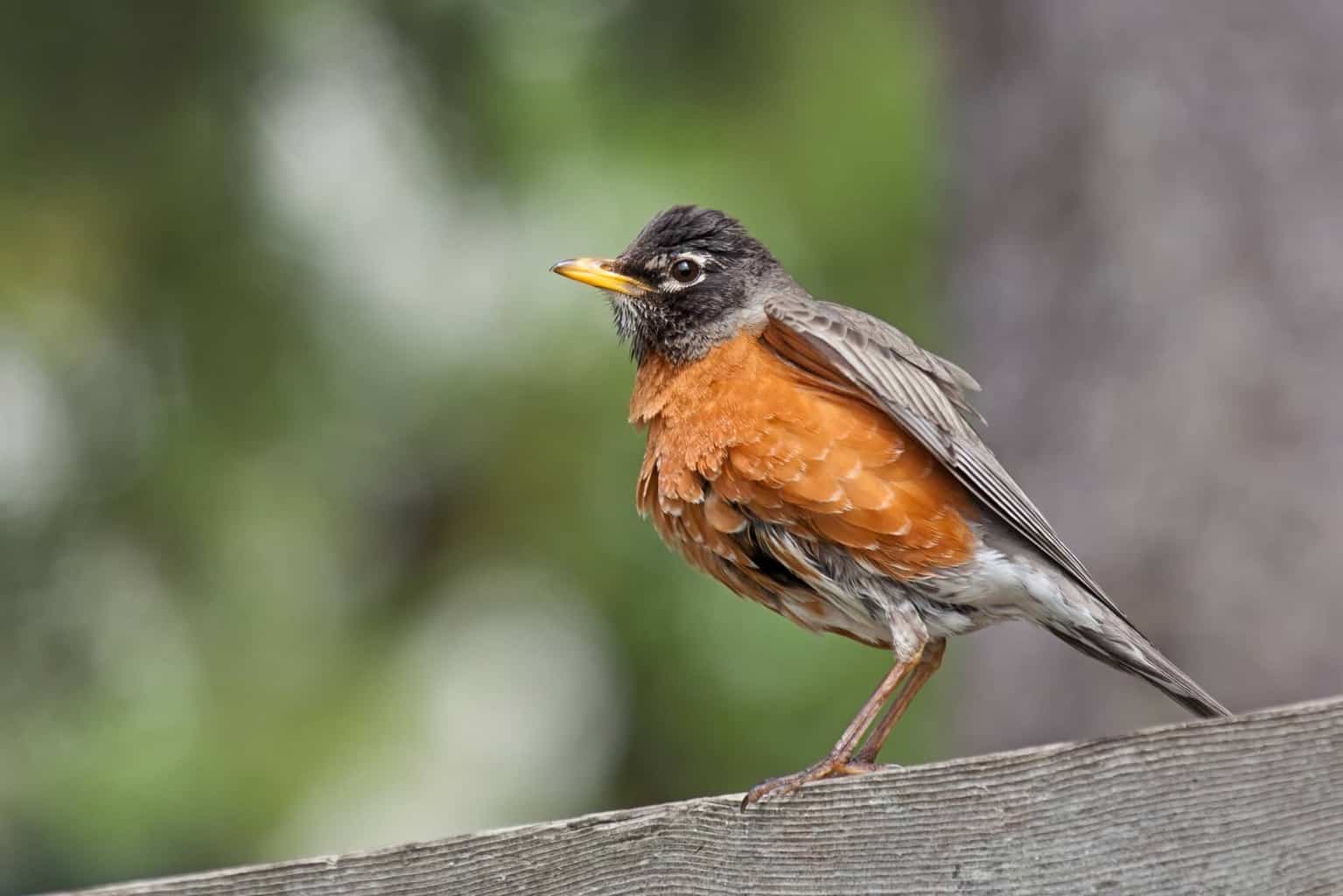
- Length: 7.9-11.0 in (20-28 cm)
- Weight: 2.7-3.0 oz (77-85 g)
- Wingspan: 12.2-15.8 in (31-40 cm)
One of the five most common birds in North America, the American Robin lives across the entire continent and stays in most of the United States year-round.
Males and females are grayish-brown. Males have dark, rusty brown breasts and dark heads, while females have paler heads and more muted coloring on the rest of their bodies. Both sexes have dark eyes and black-tipped yellow bills.
You’ll most likely hear American Robins in the spring. They string about 10 steadily repeated whistles together. Children are often taught to recognize a robin by listening for, “Cheerily, cheer up! Cheer up! Cheerily, cheer up!” The song is much faster in the morning than it is later in the day, and in addition to the cheer-up song, robins also make tuk, chirr, and chirp sounds.
American Yellow Warbler
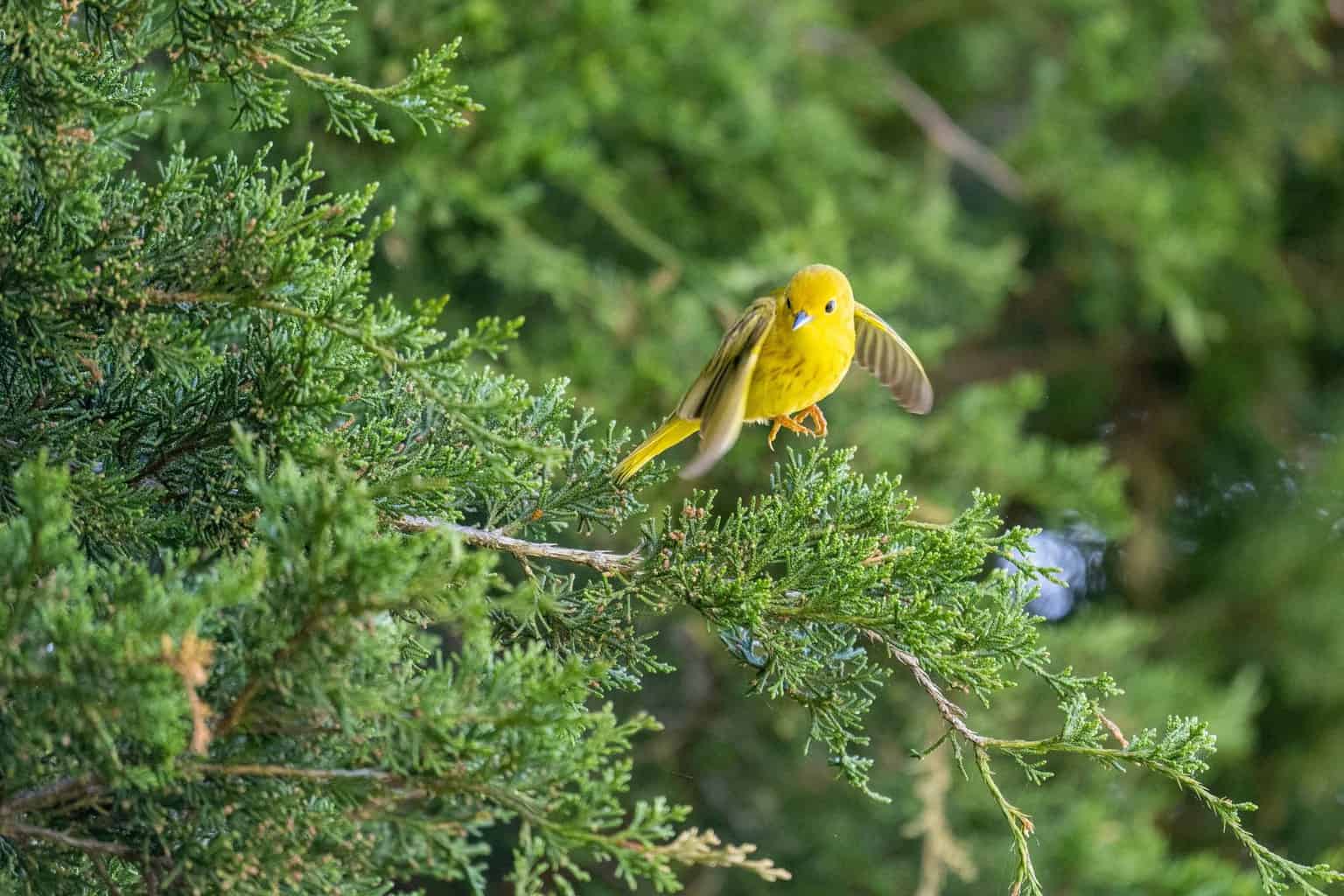
- Length: 4.7-5.1 in (12-13 cm)
- Weight: 0.3-0.4 oz (9-11 g)
- Wingspan: 6.3-7.9 in (16-20 cm)
Male and female American Yellow Warblers are both predominantly yellow, their only major difference being that males are a bit more vibrant.
These small songbirds can be found in most of North America. During the breeding season, they live in Canada and most of the U.S. They migrate through the South and Southeast, spending the winter in Central and South America.
The Yellow Warbler’s sounds include both a song — they’re more likely to sing in the spring and summer — and a call. The male’s song consists of 6 to 10 whistled notes, all within just about a second. The song ends on a rising note and is often described as sounding like, “Sweet, sweet, sweet, I’m so sweet!”
The bird’s call is a metallic-sounding series of chips. Males and females use these calls to reply to one another.
Baltimore Oriole
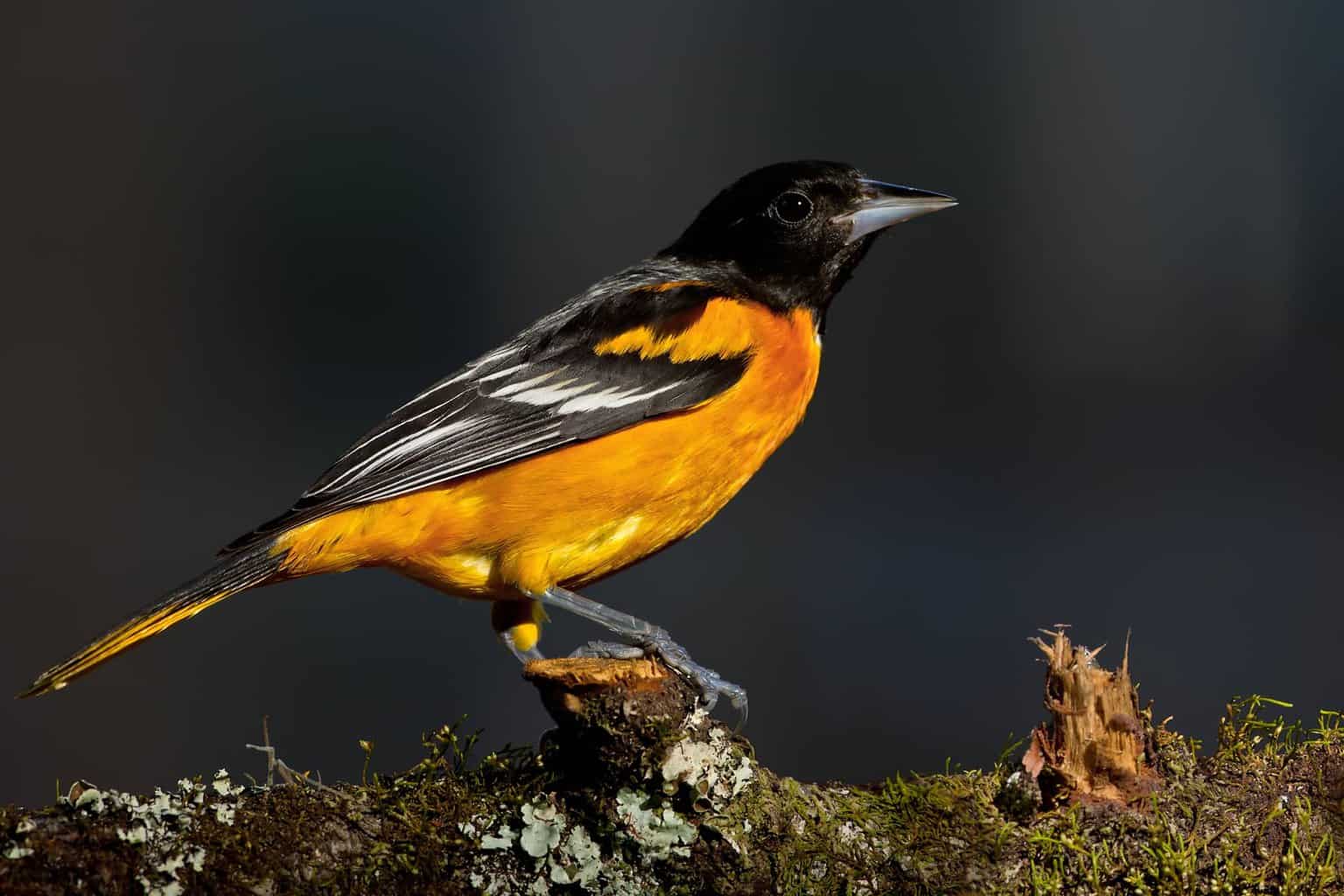
- Length: 6.7-7.5 in (17-19 cm)
- Weight: 1.1-1.4 oz (30-40 g)
- Wingspan: 9.1-11.8 in (23-30 cm)
Baltimore Oriole males are orange and black while females are yellowish-orange and gray. Their diet includes lots of fruit, so many backyard birders put jellies and fruits in dedicated oriole feeders to entice them to their yards. Check out some of our favorite oriole feeders here.
You won’t hear Baltimore Orioles in the western half of the U.S. They breed in the Midwest, Northeast, and much of the Southeast and spend their winter season in southern Florida, southern Mexico, and the Caribbean.
If you live in the Baltimore Oriole’s territory, you’ll hear its sounds in the springtime. The male makes a series of paired notes that repeat between two and seven times. The song lasts for one to two seconds before pausing and repeating.
Males and females can chatter when they are in conflict or behaving in a territorial manner. Unlike the morning song, this sound is more likely to be heard all day. They can also chuck and scream.
Gartered Trogon

- Length: 9.1-9.8 in (23-25 cm)
- Weight: 1.3-2.0 oz (38-57 g)
The Gartered Trogon is a North American bird, but you’re pretty much out of luck if you live in the U.S. or Canada and want to hear its sounds. Gartered Trogons only inhabit the southern east coast of Mexico, Central America, and the northern edges of South America.
These vibrant blue-and-yellow birds spend their time high in the canopy of the rainforest. On the underside of both the male and female’s tails, they have black and white barring.
The Gartered Trogon’s song is lengthier than other birds. He lets out a long series of “downslurred” notes to sing, and a chattering sound for a call. The song sounds a bit like, “Kyu-kyu-kyu-kyu-kyu-kyu.”
Red-Winged Blackbird

- Length: Up to 9 in (22.86 cm)
- Weight: 1.1 – 2.7 oz (32 – 77 g)
- Wingspan: 12.2 – 15.8 in (31 – 40 cm)
The male Red-Winged Blackbird has glossy black feathers on his wings and body, with red and yellow markings that curve along each of his shoulders. Females are dark brown, and they have white wing bars and a pale breast.
Red-winged blackbirds are year-round residents in most of the U.S., while Canada and the northern strip of the United States see them exclusively during the breeding season.
Males make a sound like, “Conk-la-ree.” At only 1 second, the song is fast, with a single note followed by a trill. Females reply to the males with 3-5 notes that sound like “chit-chit-chit-chit” or “check-check-check-check.”
Red-winged blackbirds make their calls throughout the year, unlike birds that are noisy in the springtime and quiet for the rest of the year. When alarmed, they will intensify their call and produce it with more enthusiasm. These birds are fiercely territorial, and one reason they sing in the morning is to announce their presence to any other birds in the area.
Tufted Titmouse
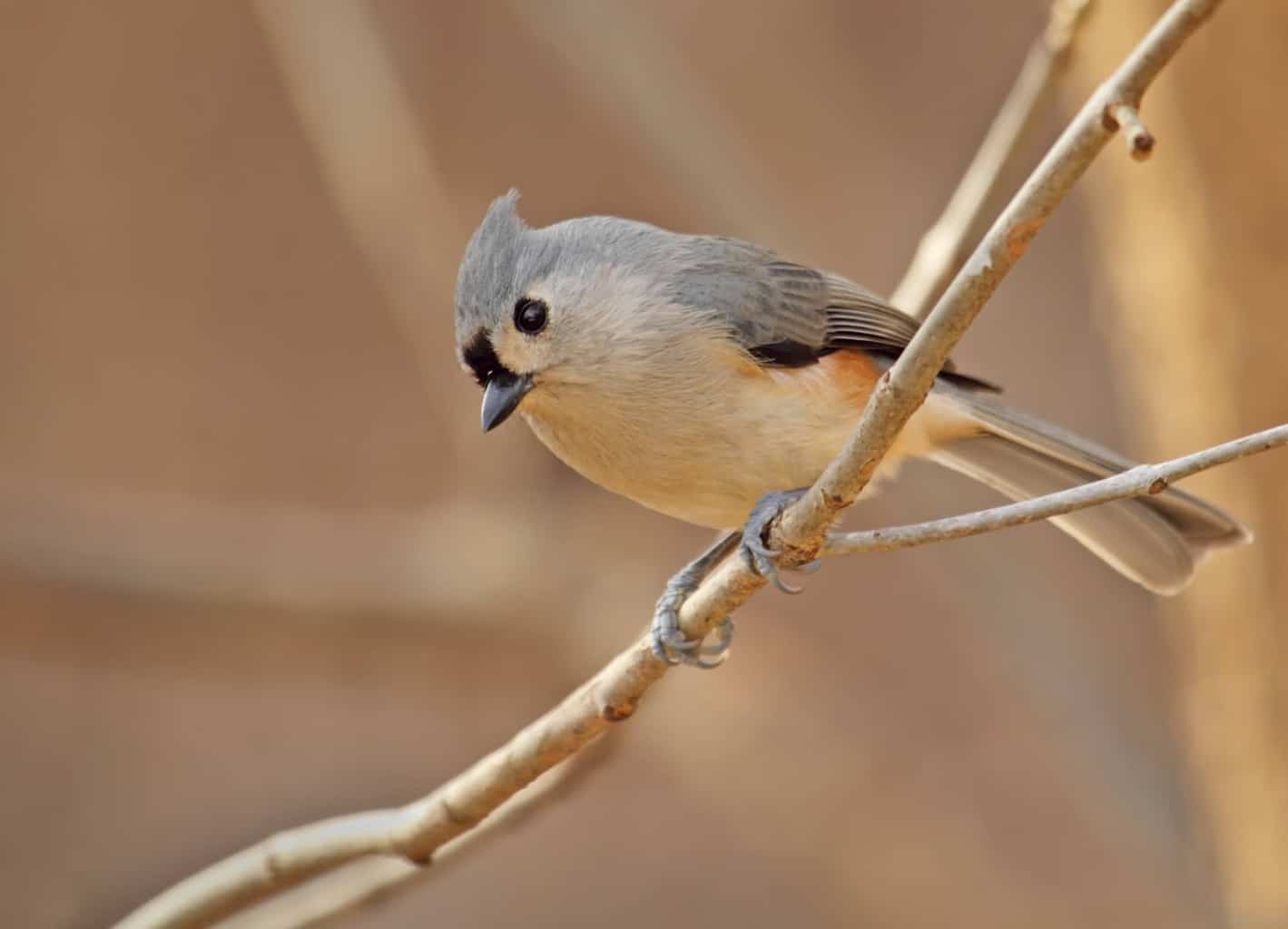
- Length: 5.5-6.3 in (14-16 cm)
- Weight: 0.6-0.9 oz (18-26 g)
- Wingspan: 7.9-10.2 in (20-26 cm)
What a cute little bird! The Tufted Titmouse is a lovely gray color with peachy-orange tones showing up along the wings. Males and females look alike, sporting a cute crest atop their heads.
They are non-migratory, and their range includes the eastern half of the United States, from Maine to Florida, and just a bit west of the Mississippi River.
The Tufted Titmouse whistles a very clear song that sounds like “Peter, Peter, Peter!” They will repeat this sound up to 11 times in a row — about 35 songs per minute! You’re most likely to hear males in the morning, but females will sometimes reply with a softer version of the same song.
Morning-Singers Outside of North America
There are morning songbirds outside of North America, singing in Europe, Asia, Australia, and all over the world. Read on to find out what you’re likely to hear if you call another continent home.
Common Chiffchaff
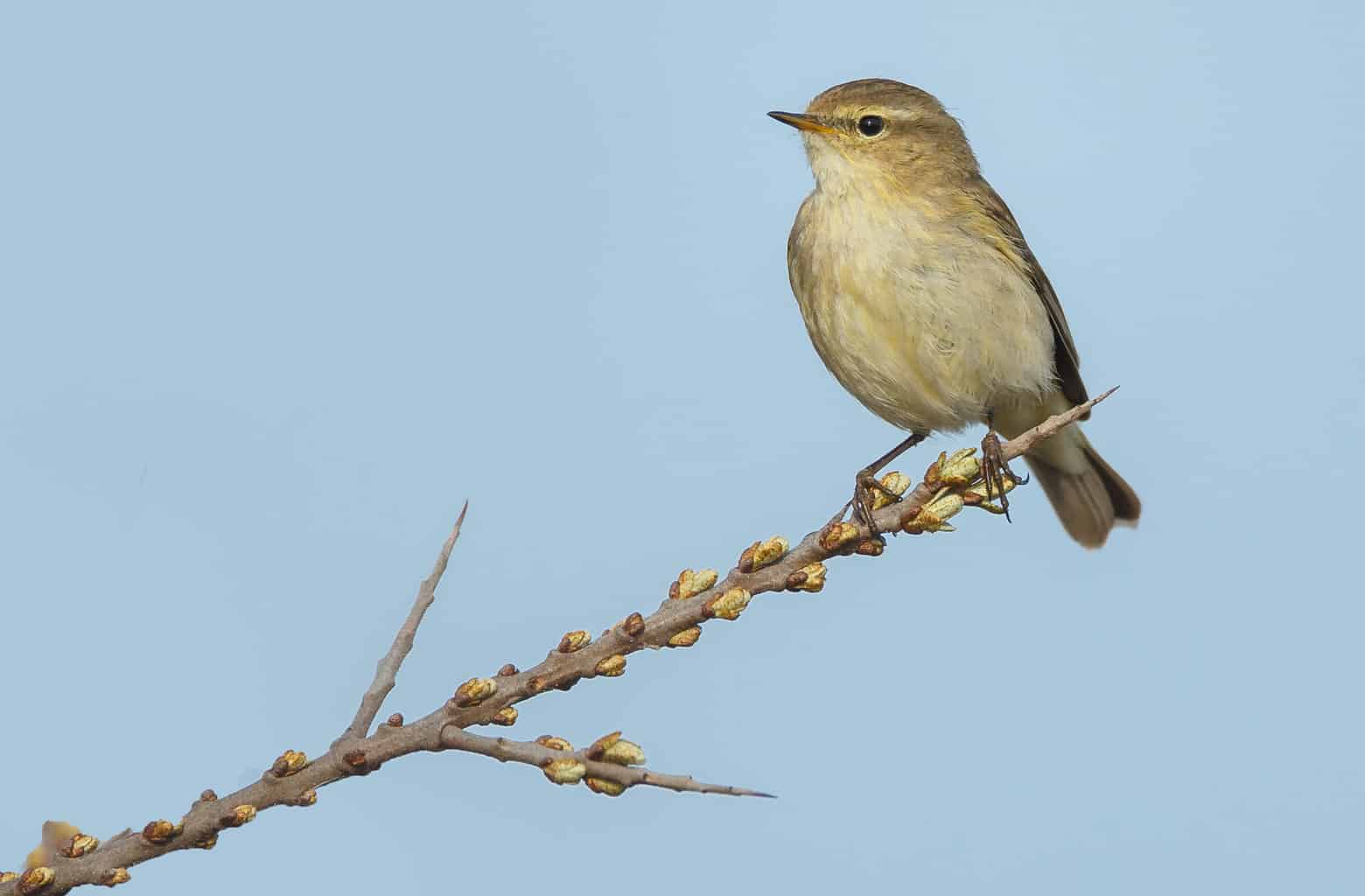
The Common Chiffchaff is incredibly common in Europe, Northern Africa, and parts of India and Asia.
It is a grayish-brown warbler that has a hint of yellow to its feathers. Chiffchaffs live in wooded areas, usually very close to the water’s edge.
When it sings, the Common Chiffchaff makes a high-pitched, fast-paced series of similar notes, singing, “Suit-suit-suit-suit.” Its name also comes from a part of its song, which sounds like “Chiff-chaff, chiff-chaff, chiff-chaff.”
Song Thrush

The Song Thrush was once plentiful in Europe, but its population is declining. You’ll see these birds in woodlands, parks, and farms; they like to have safe cover nearby to escape into if they are startled.
Males and females are very similar in appearance, with brown backs and white bellies. They have spots on their breast that are shaped like water droplets.
They are quite vocal, which explains where they get their name! Song Thrushes repeat the same phrase over and over again. First, they will repeat one phrase three or four times. Then, a second phrase three or four more times.
Why Do Birds Sing in the Morning?
Naturalists and biologists don’t know every reason birds sing in the morning, but they do know some of them. We’ve done our research and discovered three of them: to attract mates, to warn others that predators are near, or because they have nothing else to do.
Attracting a Mate
When you hear the dawn chorus, the symphony of bird sounds occurring every morning, most of the birds you hear are males demonstrating what excellent mates they would be. A weak, sickly bird cannot sing a robust, attractive song, so males show off how strong and vocal they are.
If a bird already has a mate, he may still sing as a way to impress her, interact with her, and confirm that he is still strong and healthy.
Warning of Predators
Some bird calls function as ways to intimidate predators or tell other birds there is a threat nearby.
For example, when a hawk is spotted nearby, Blue Jays will shriek and screech at one another, sounding the alarm. This potentially deters the hawk and successfully warns other birds in the area to be on the lookout!
Nothing Else To Do
It could be that birds sing in the morning because that’s the time of day when they have fewer available activities.
Birds wake before the sun comes up, but it’s often too early for hunting or finding food. Insects aren’t active at these early hours, and it’s too dark to find birdseed, berries, and fruit. Some researchers believe that birds sing in the morning because it’s just the perfect time of the day compared to the hours they need to spend foraging, feeding, migrating, and raising young.
Which Bird Is the Loudest in the Morning?
South America’s White Bellbird is the loudest bird on record. The male’s mating call has two parts, measuring over three times the level of sound pressure. They sound like someone in the forest is banging on a piece of metal.
If you’re not in the rainforests of South America, the loudest birds you’ll probably hear are the ones on this list! American Robins, American Warblers, and Red-Winged Blackbirds are among the loudest backyard birds in nature.
Enjoy the Birds Tomorrow Morning!
I hope you take some time to enjoy the beautiful songs of your neighborhood birds in the morning. You’re hearing more than just a song or call. You’re listening to a large community of birds, interacting and communicating with each other. You never know what you’ll hear, and I think that’s exciting.
Let the Cornell Lab of Ornithology’s Merlin app be your listening partner. The app helps you identify birds by inputting what you see or hear, and it even has an “identify by sound” feature.
Just turn the audio recorder on when you hear an interesting bird, and Merlin will run the sound through a database of potential matches. In just a few minutes, you’ll have an answer. Its accuracy is impressive, and, in my opinion, it’s a worthwhile tool to have with you while birding. What’s more, it comes from the Cornell Lab of Ornithology, and they’re one of the leading voices in birding today — you can trust what they put out.
Enjoy the Dawn Chorus!

